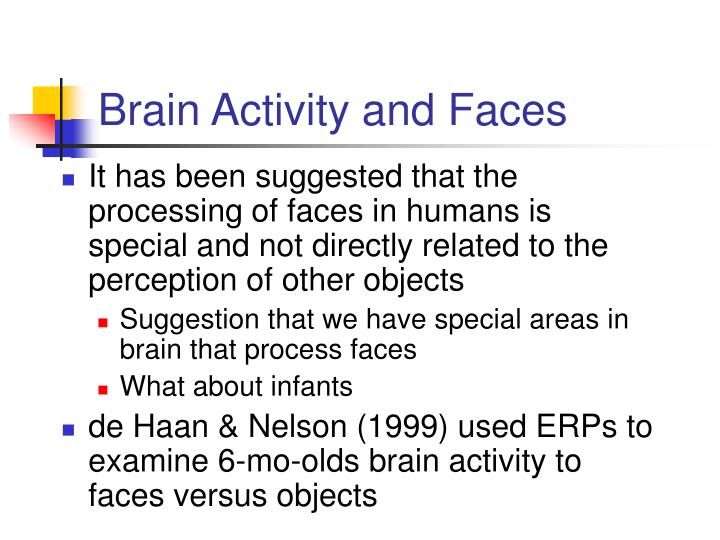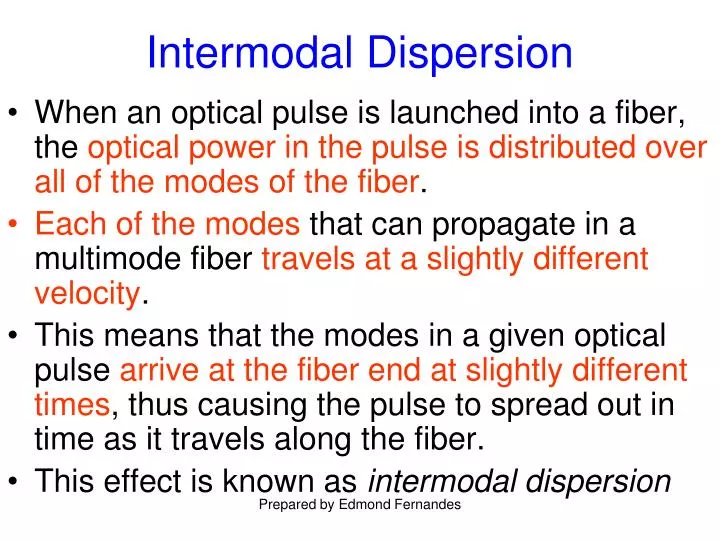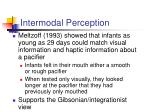

Asynchronous test trials where sound occurred either before or after bounce.

Familiarized with bouncing green disk and a sound at each.Researchers have looked at the object/event properties that support integration and the development of infants’ sensitivity to these properties.

The other school of thought proposes that young infants are unable to integrate information across modalities and that this ability develops over the first year.Supports the Gibsonian/integrationist view.When tested only visually, they looked longer at the pacifier that they had previously only mouthed.Infants felt in their mouth either a smooth or rough pacifier.Meltzoff (1993) showed that infants as young as 29 days could match visual information and haptic information about a pacifier.Then tested with the visual modality with a rigid and elastic object simultaneously.So, familiarized 12-mo-olds either haptically (touch) or visually to either a rigid object or an elastic object.Question: Do infants differentiate visual information about rigidity versus deformation of an object (haptic information).The information is invariant across modalities.Thus, perception is amodal - the information is not perceived as coming from any particular modality.Information from the senses is initially integrated and with development become differentiated.Question: When and how do infant’s become sensitive to this multi-modal information.Further this information is coordinated across the senses.Instead they contain information detected by multiple senses.Objects and events in the infant’s perceptual world do not contain just either visual, auditory, etc.Infant visual fixation on motion pictures of the human face. Brief report: Preferential looking in intermodal perception by children with autism, J. (ed.), Advances in Infancy Research, Ablex, Norwood, NJ, pp. Infants' perception of the affordances of expressive behaviors. Intermodal perception of expressive behaviors by human infants. Infants' intermodal perception of events. (ed.), Handbook of Infant Development, Wiley, New York, pp. Autistic children's knowledge of thinking and feeling states in other people. Prior, M., Dahlstrom, B., and Squires, T. Recognition of facial expressions by seven-month-old infants. Intermodal perception of affect in persons with autism or Down syndrome.

A., Tunali-Kotoski, B., Chen, R., Brelsford, K. (1987) Pretense and representation: The origins of “theory of mind”. Infants' Reactions to Different Expressions of Emotions, Society for Research in Child Development, Philadelphia. Autistic disturbances of affective contact. The Maximally Discriminative Facial Movement Coding System (MAX), University of Delaware, Newark, DE. (1994) Differential responses to emotion in children with autism, Dissertation, Rutgers University. Emotion recognition in autism: Coordinating faces and voices. (eds.), Autism: New Perspectives on Diagnosis, Nature and Treatment, Guilford Press, New York. The autistic child's appraisal, of expressions of emotion. The Ecological Approach to Visual Perception, Lawrence Erlbaum Associates, Inc., Hillsdale, NJ. Autism: Explaining the Enigma, Blackwell, Oxford. The responsiveness of autistic children to the predictability of social and nonsocial toys. (eds.), Autism: Nature, Diagnosis and Treatment, Guilford, New York, pp. Arousal, attention, and the socio-emotional impairments of individuals with autism. Does the autistic child have a “theory of mind”? Cognition 21: 37–46.ĭawson, G., and Lewy, A.


 0 kommentar(er)
0 kommentar(er)
